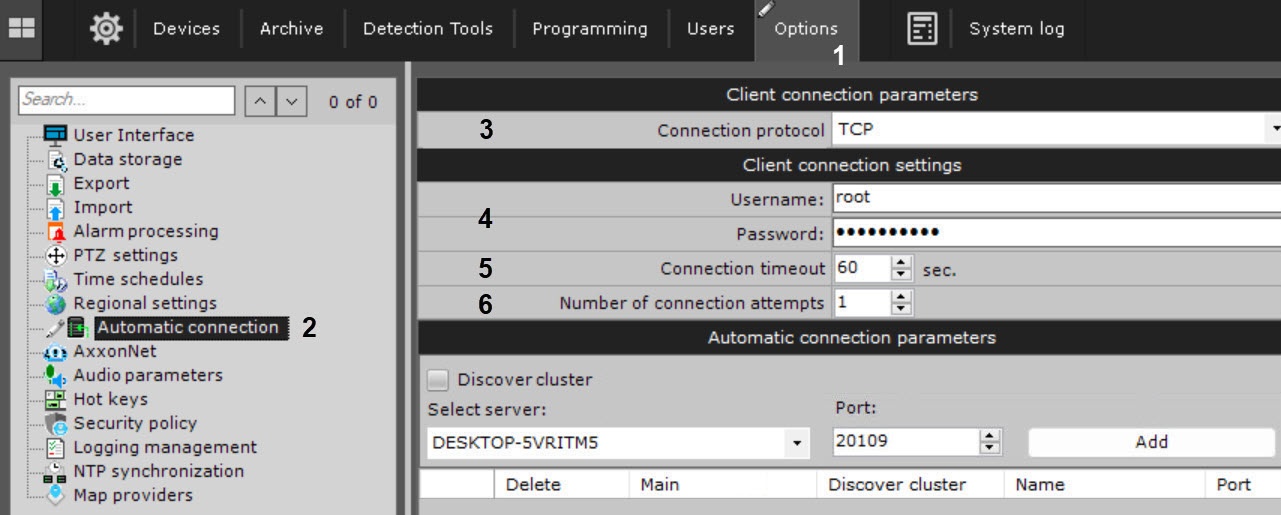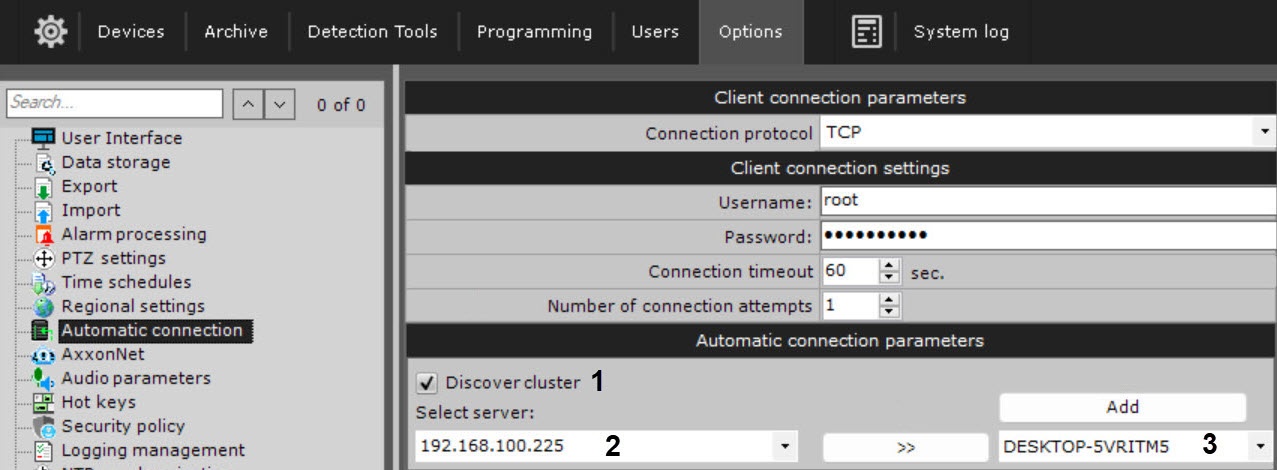
Go to documentation repository
Page History
| Section | |||||||||||||||||||||
|---|---|---|---|---|---|---|---|---|---|---|---|---|---|---|---|---|---|---|---|---|---|
|
General information about configuring Automatic connection
This setting is used to automatically connect:
- the Client to the Server without having to re-enter the Server name, username and password when starting the app;
- the Client to Servers belonging to different domains (see Cross-System client);
- the Client to the nodes of the FailOver system (see Configuring Failover VMS).
If you connect automatically, the Servers specified in the Automatic connection parameters group will be used first. If these Servers are unavailable, the system will try to connect to the Servers from the Preferred servers parameters group following the set order (see Selecting Preferred Servers).
Configuring Automatic connection
To configure automatic connection, do the following:
- Select the Options tab (1) → Automatic connection (
It is possible for the Client to automatically connect to Servers on different Axxon domains—Cross-System Client.
For this to take place, the following conditions must be true:
- Professional or Universe license has been activated on each Server to which the Client is connected;
- connection to all Servers made via with the same user name/password combination on each Axxon domain;
Server names and IP addresses are unique.
Configuration of automatic connection to Servers on different Axxon domains is performed as follows:
- Go to Settings → Options → Automatic connection (1-2).
- Configuring the protocol used by Clients to connect to the Server allows prioritizing reliability or speed of data transmission From the drop-down list (3). The , select the connection protocol is set individually for each Server in an Axxon-domain. All Clients connected to the Server will receive video streams over the selected protocol.Descriptions and recommendations for selecting a protocol .
Description of the protocol and recommendations for selection are given in the table.Protocol Description TCP This protocol is more reliable but bandwidth-intensive. Recommended , but has a busy connection. We recommend selecting it for Servers with a small numbers number of cameras UDP unicast UDP is typically faster but less reliable for data transmission. Unicast involves data transmission protocol has a higher data transmission speed, but it is less reliable. The unicast scheme is used to transmit data to a single recipient.
This protocol is best for Servers with many cameras connected to a single Client.You must select this protocol for a Server with a large number of cameras and which has several Clients working with itUDP multicast Multicast refers to data transmission The multicast scheme is used to transmit data to a group of recipients. This protocol is designed best suited for Servers with many cameras connected to multiple Clients.Importanta Server with a large number of cameras and which has many Clients working with it.
Attention! This protocol has to must be supported by all network components, in particular, switches. - Type the user name and password needed for logging in to each Axxon domain (4).
- The connection protocol of the Clients to the Server determines the choice either in favor of connection reliability or in favor of data transmission speed. You must select the connection protocol for each Sever of the domain. All Clients connected to the Server will receive video streams via this protocol.
elements, including switches
- For automatic authorization when connecting to Servers, enter the username and password (4). If you leave these fields blank, authorization will be performed manually when you start the Client.
Note title Attention! Cross-System Client connects to all Servers using a single username-password pair that must be created in each domain (see Cross-System client).
- In the Connection timeout field (5), specify the wait period Specify the Connection timeout parameter (5), which determines how long one must wait for a successful connection before considering the attempt to be unsuccessful. The default timeout value is 60 seconds, the maximum value is 300 seconds (5 minutes). When using If you use this setting, an automatic connection attempt will attempt to connect occur immediately. If the connection fails, the Server will wait for a user-specified the period of time specified by the user (timeout) and retry repeat the connection attempt.
- Specify the maximum number of automatic connection attempts after the specified timeout (6).
- Indicate Specify the Servers to which you want to connect to. For each Server, perform do the following steps:
- Select a Server from the list or enter the Server IP address
- select the Server in the list (7);.
- indicate Specify the port for connecting to the Server (8).
Info title Note If you leave the Port field is left blank, the standard port (20111) 20109 will be used for connectingconnection.
- Click the Add button (9).
Info title Note It is possible to - If you use Cross-System Client, you can connect to only one Server
- of each domain (see Cross-System client). That is why when you add a Server to the list, all other Servers
- in that domain become unavailable for selection.
Info title Note - To remove a Server from the list, click the button
- .
Configuration of automatic connection of the Client to Servers is complete. The next time you start Axxon One, it will connect to the selected Servers.
Configuration of automatic connection of the Client to Servers located in different domains
When you use Cross-System Client, select the main domain after adding all Servers to the list. To select the main domain, set the Main checkbox in the corresponding column of the Server that is on the domain.
When connecting, the Client will use the parameters (maps, layouts, user
...
permissions) of the main
...
domain.
...
Configuration of automatic connection of the Client to the nodes of the FailOver system
If you want to configure automatic connection to a node of the FailOver system, do the following:
- Set the Discover cluster checkbox (1).
- Enter the IP address of any Server of the cluster (2) and click the button.
- From the drop-down list (3), select a node that you want to add to autoloading.
- Click the Add button.
- Click the Apply button.
Configuration of automatic connection of the Client to the node of the FailOver system is complete.
Changing the Server port
To change the port of an already
...
Click Export (1) to save the automatic Server connection and Preferred Servers (see Selecting Preferred Servers) configuration to the JSON file.
To load the preset configuration to other Clients, do the following:
- Click Import (2).
- Click Apply.
To change a port on an added Server, do the following:
- Select this the Server again from the list again (1).
- Enter a new port In the Port field (2), specify a new number.
- Click the Edit button (3).
Auto-connection to Servers on different Axxon domains is now complete.
The next time Axxon Next is started, connection to the selected Servers with the specified user credentials will occur automatically.
If the Client is connected to several Servers, the Server settings are reproduced for each Server (see Server settings).
Changing the port of the added Server is complete.
Exporting and importing the configuration of automatic connection
To save the configuration of automatic connection to Servers and preferred Servers (see Selecting Preferred Servers) to a JSON file, click the Export button.
To load the configuration on the Clients, do the following:
- Click the Import button.
- Click the Apply button.
...









